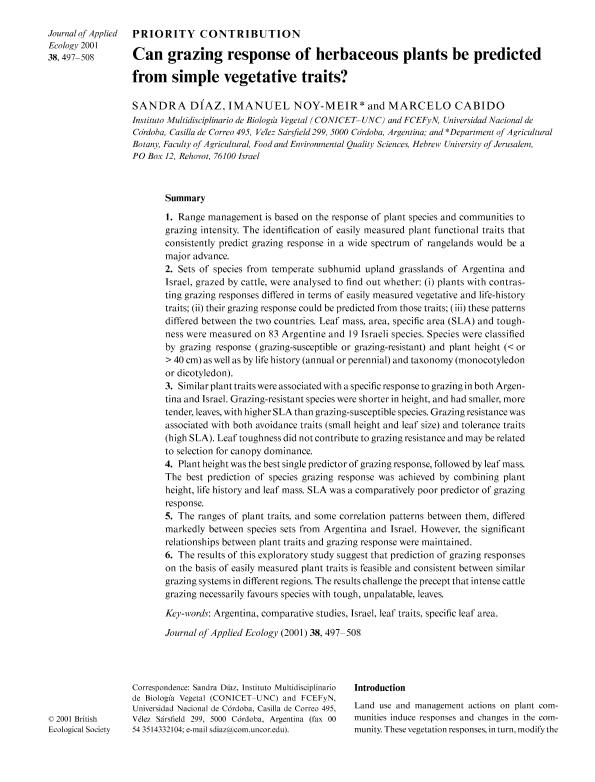Mostrar el registro sencillo del ítem
dc.contributor.author
Díaz, Sandra Myrna

dc.contributor.author
Noy Meir, Imanuel
dc.contributor.author
Cabido, Marcelo Ruben

dc.date.available
2018-01-31T14:27:43Z
dc.date.issued
2001-07
dc.identifier.citation
Díaz, Sandra Myrna; Noy Meir, Imanuel; Cabido, Marcelo Ruben; Can grazing response of herbaceous plants be predicted from simple vegetative traits?; Wiley Blackwell Publishing, Inc; Journal of Applied Ecology; 38; 3; 7-2001; 497-508
dc.identifier.issn
0021-8901
dc.identifier.uri
http://hdl.handle.net/11336/35181
dc.description.abstract
Range manafement is based on the response of plant species and communities to grazing intensity. The identification of easily measured plant functional traits that consistently predict grazin response in a wide spectrum of rangelands would be major advance. Sets of species from temperate subhumid upland grasslands of Argentina and Israel, grazed by cattle, wer analised. Similar plant traits were associated with a specific response to grazing in both Argentina and Israel. Grazing resistant species were shorter in height, and had smaller, more tender leaves, with higher SLA than grazing susceptible species. Plant height was the best sigle predictor of grazing response, followed by leaf mass. The best prediction of species grazing response was acchieved by combining plant height, life istory and leaf mass. SLA was a comparatively poor predictor of grazing response.<br />5- The ranges of plant traits, and some correlation patterns between them, differed markedly between species sets from Argentina and Israel, However, the significant relationships be4tween plant traits and grazing response were mainteined. The results of this exploratory study suggest that preciction of grazing responses on the basis of easily measured plants traits is feasible and consistent between similar grazing systems in different regions. The results challenge the precept that intense cattle grazing necessarily favours species with tough, unpalatable leaves.
dc.format
application/pdf
dc.language.iso
eng
dc.publisher
Wiley Blackwell Publishing, Inc

dc.rights
info:eu-repo/semantics/openAccess
dc.rights.uri
https://creativecommons.org/licenses/by-nc-sa/2.5/ar/
dc.subject
Argentina
dc.subject
Comparative Studies
dc.subject
Israel
dc.subject
Leaf Traits
dc.subject
Specif Leaf Areas
dc.subject.classification
Otras Ciencias Biológicas

dc.subject.classification
Ciencias Biológicas

dc.subject.classification
CIENCIAS NATURALES Y EXACTAS

dc.title
Can grazing response of herbaceous plants be predicted from simple vegetative traits?
dc.type
info:eu-repo/semantics/article
dc.type
info:ar-repo/semantics/artículo
dc.type
info:eu-repo/semantics/publishedVersion
dc.date.updated
2018-01-24T14:31:18Z
dc.identifier.eissn
1365-2664
dc.journal.volume
38
dc.journal.number
3
dc.journal.pagination
497-508
dc.journal.pais
Reino Unido

dc.description.fil
Fil: Díaz, Sandra Myrna. Consejo Nacional de Investigaciones Científicas y Técnicas. Centro Científico Tecnológico Conicet - Córdoba. Instituto Multidisciplinario de Biología Vegetal. Universidad Nacional de Córdoba. Facultad de Ciencias Exactas Físicas y Naturales. Instituto Multidisciplinario de Biología Vegetal; Argentina
dc.description.fil
Fil: Noy Meir, Imanuel. Consejo Nacional de Investigaciones Científicas y Técnicas. Centro Científico Tecnológico Conicet - Córdoba. Instituto Multidisciplinario de Biología Vegetal. Universidad Nacional de Córdoba. Facultad de Ciencias Exactas Físicas y Naturales. Instituto Multidisciplinario de Biología Vegetal; Argentina. The Hebrew University of Jerusalem; Israel
dc.description.fil
Fil: Cabido, Marcelo Ruben. Consejo Nacional de Investigaciones Científicas y Técnicas. Centro Científico Tecnológico Conicet - Córdoba. Instituto Multidisciplinario de Biología Vegetal. Universidad Nacional de Córdoba. Facultad de Ciencias Exactas Físicas y Naturales. Instituto Multidisciplinario de Biología Vegetal; Argentina
dc.journal.title
Journal of Applied Ecology

dc.relation.alternativeid
info:eu-repo/semantics/altIdentifier/url/http://onlinelibrary.wiley.com/doi/10.1046/j.1365-2664.2001.00635.x/full
dc.relation.alternativeid
info:eu-repo/semantics/altIdentifier/doi/http://dx.doi.org/10.1046/j.1365-2664.2001.00635.x
Archivos asociados
